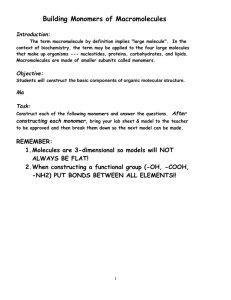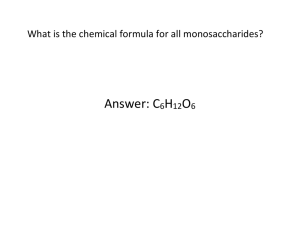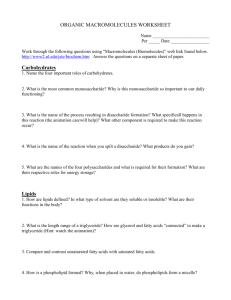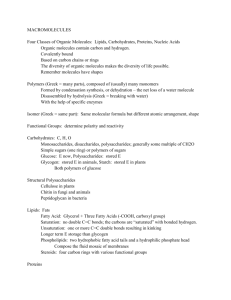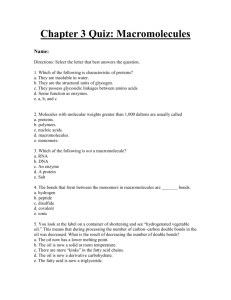C5 Macromolecules
advertisement
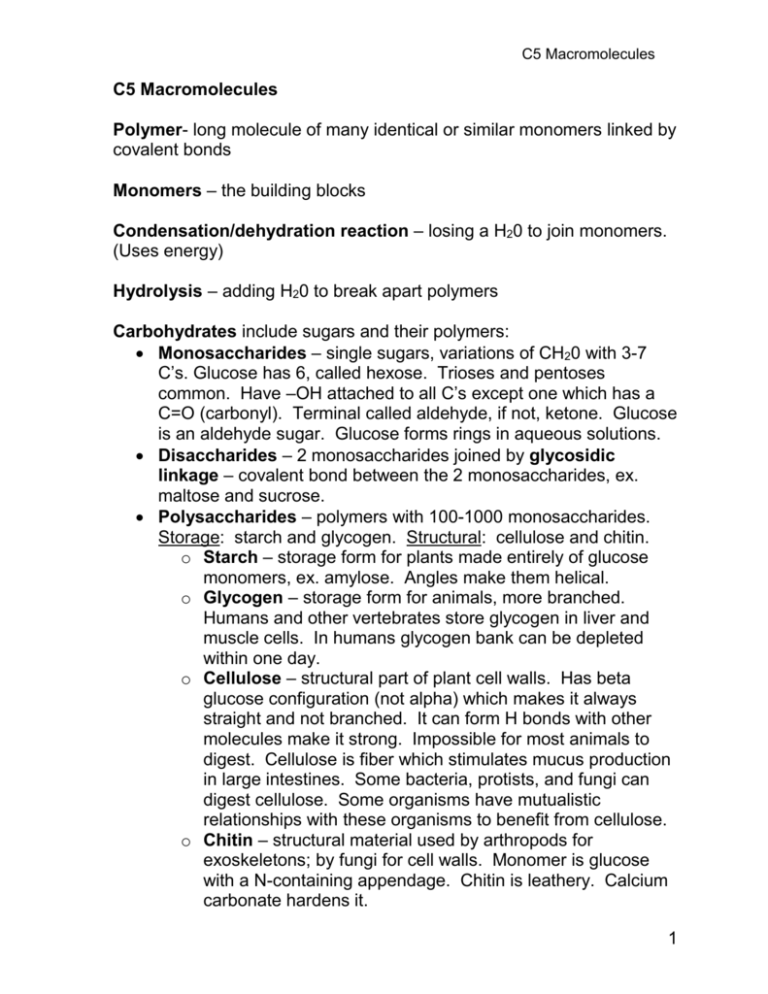
C5 Macromolecules C5 Macromolecules Polymer- long molecule of many identical or similar monomers linked by covalent bonds Monomers – the building blocks Condensation/dehydration reaction – losing a H20 to join monomers. (Uses energy) Hydrolysis – adding H20 to break apart polymers Carbohydrates include sugars and their polymers: Monosaccharides – single sugars, variations of CH20 with 3-7 C’s. Glucose has 6, called hexose. Trioses and pentoses common. Have –OH attached to all C’s except one which has a C=O (carbonyl). Terminal called aldehyde, if not, ketone. Glucose is an aldehyde sugar. Glucose forms rings in aqueous solutions. Disaccharides – 2 monosaccharides joined by glycosidic linkage – covalent bond between the 2 monosaccharides, ex. maltose and sucrose. Polysaccharides – polymers with 100-1000 monosaccharides. Storage: starch and glycogen. Structural: cellulose and chitin. o Starch – storage form for plants made entirely of glucose monomers, ex. amylose. Angles make them helical. o Glycogen – storage form for animals, more branched. Humans and other vertebrates store glycogen in liver and muscle cells. In humans glycogen bank can be depleted within one day. o Cellulose – structural part of plant cell walls. Has beta glucose configuration (not alpha) which makes it always straight and not branched. It can form H bonds with other molecules make it strong. Impossible for most animals to digest. Cellulose is fiber which stimulates mucus production in large intestines. Some bacteria, protists, and fungi can digest cellulose. Some organisms have mutualistic relationships with these organisms to benefit from cellulose. o Chitin – structural material used by arthropods for exoskeletons; by fungi for cell walls. Monomer is glucose with a N-containing appendage. Chitin is leathery. Calcium carbonate hardens it. 1 C5 Macromolecules Lipids – highly varied group of hydrophobic compounds including fats, phospholipids, steroids, waxes, and pigments. Fat – made of glycerol and fatty acids Glycerol – an alcohol with 3 C’s, each with a –OH group. Fatty acid – a long C skeleton (usu. 16-18 C’s) with a carboxyl group, -COOH. Thus, acid. “Tail” made of hydrocarbons Ester linkage – bond between glycerol and the fatty acids Triglyceride – another name for fat, also triacylglycerol Saturated fatty acid – no double bonds between C’s; usu. Solids at room temperature (RT) Unsaturated fatty acid – has one or more double bonds between C’s creating a kink; usu. Liquid at RT Hydrogenated – synthetically converted unsaturated fats to saturated by adding H; seen in peanut butters… Functions of fat is energy storage, membrane structure, cushioning vital organs, and to insulate. 1 g of fat has 2X as much energy as 1 g of starch. Phospholipids – have 2 fatty acids and a phosphate group. Phospholipids put in water arrange into a “micelle”. Plasma membrane uses the double layer arrangement: phosphate, lipid, lipid, phosphate. Steroids – lipids with a C skeleton of 4 fused rings Cholesterol – common in cell membranes; precursor to steroids. Sex hormones made from cholesterol. Proteins most structurally sophisticated molecules known made from 20 amino acids; account for over 50% dry weight of most cells; human has 10’s of 1,000’s of proteins each with a specific structure and function. Functions: o Structural support o Storage o Signaling o Transport o Movement o Defense o Regulate metabolism (enzymes) Conformation – unique 3-D shape dependent upon: pH, salt concentration, temperature, solvent type, exposure to chemicals… Polypeptides – polymers of amino acids 2 C5 Macromolecules Amino acids – organic molecules with amino and carboxyl groups. The center C is asymmetric. Peptide bond – covalent bond between amino acids Levels of protein structure: o Primary structure – sequence of amino acids o Secondary structure – repeated coils or folds from H bonding o Tertiary structure – 3-D irregular structure that results from bonding between side chains of the various amino acids; Types of bonding: hydrophobic interaction, Van der Waals forces, H bonds, ionic bonds, and disulfide bridges. o Quaternary structure – if it has 2 or more polypeptide chains. Denatured – protein that becomes misshapen due to a change in pH, salt concentration, temperature, or exposure to chemicals Chaperone proteins – molecules that function as temporary braces in assisting the folding of other proteins Nucleic acids – store cellular information in code form, ex. DNA or RNA: Gene – inheritance unit on a chromosome, made mostly of DNA DNA – deoxyribonucleic acid, provides directions for its own replication and controls protein synthesis through RNA RNA – ribonucleic acid; messenger RNA leaves nucleus and directs protein synthesis in the cytoplasm. Nucleotides – monomers of nucleic acid made of 3 parts: nitrogen base, 5-C sugar, and a phosphate group Ribose – pentose sugar Deoxyribose – pentose sugar that lacks an O on number 2 C Phosphodiester linkages – bonds between the phosphate of one nucleotide and the sugar of the next. Nitrogen base families: Pyrimidines – have 6-membered C ring and N atoms, C,T,U Purines – larger, 6-membered ring fused to 5-membered ring, A,G 3

